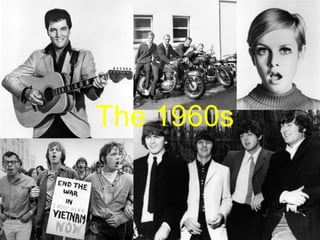
1960s Events: Kennedy, Music, Space
- 1. The 1960s
- 2. Events • • • • Assassination of President Kennedy (1963) British pop/rock music First man in space(1961) Woodstock(1969)
- 3. Op art • Victor Vasarely began this movement with his 1938 painting ‘zebra’ • Abstract and Expressionist movements helped form op art due deconstructing subject matters. • Bridget Riley, Victor Vasarely, Marina Apollonio, Richard Anuskiewitz and Julian Stanczak were the first Opital artists. • In 1964 ‘Time magazine’ gave it the name‘op art’. After reviewing the responsive eye exhibition.
- 5. THE RESPONSIVE • In 1965 William. C. Seitz held an exhibition at the museum of modern art in New york city • It focused on perceptual aspects of art which result of illusion of movement and the interaction of colour relationships.
- 6. The critics hated it.
- 7. The public loved it.
- 8. • After the Responsive eye exhibition the public was fascinated with optical art. • Advertisements began to use it. They took inspiration Riley’s and Vasarely’s compositiona l styles. Riley tried to sue one fashion industry for printing her work on dresses.
- 9. Julian Stanczak • Born in Poland in 1928. • In 1940 he was taken to a concentration camp in Siberia. • There he lost the use of his right arm (which he drawn with.) He was only 10. • AT JUST 13 HE ESCAPED. He made it to Persia and joined a resistance army. Then to a refugee camp in Uganda. • At 21 he made it to America with an idea in his head of the ‘American dream’. There he made it to a shelter and was fed. The American dream was to him. ‘The feeling of being full’ • In the 50s he attended Yale. • But was his art influenced by his personal experience…..?
- 10. NO! • “Everybody was trying to push me to paint from my experience. Why do you drown in the misery of your problems? Who cares if you suffer? Everyone suffers!” • HOWEVER. The lost of his arm caused him to be careful with geometry. Any precision requires tape to create guides before paint was applied.
- 14. QUOTES “I was trying to understand how I see- how we see altogether.” “Any line creates energy” “I’m not painting for myself. I’m painting for curiosity.” “I didn’t know I was making art.”
- 15. School of London • The term ‘School of London’ was first coined by R.B. Kitaj in 1976 in his cataloge introduction to the exhibition ‘the human clay • ‘A collection of individual artists who knew each other, working in london,at the same time in the figurative style during the doom years of abstract painting’
- 16. Francis Bacon • Bacon was the inspiration and trend-setter of ‘school of London’, his success’ spurred the others to do better and be stronger artists. • Despite seeming disturbed through his painting, bacon had quite an eventful life spending his middle ages eating and drinking in London’s ‘Soho’
- 17. • The screaming scene from sergi Eisenteins ‘the battleship potemkin’ was a huge inspiration in bacons work, as one art critic, Michael Peppiatt said ‘If one could really explain the origin of this scream, one would be far closer to understanding Bacons whole art’. • He also preferred to paint on the un-primed side of the canvas.
- 18. Studio
- 20. Lucian Freud • ‘I paint people, not because of what they are like, not exactly in spite of what they are like, but how they happen to be’ • Intimate friend of Bacon, Freud benefited most from his guide. • German born British painter. • Often explored the relationship between model and artist to an uncomfortable degree.
- 22. In his later years, Freud took up a more illustrative style, with out of scale facial features and muted colours, painted with tiny sable brushes and evoke early Neatherlandish painting.
- 24. Nouveau Realism • • • • • • Also known as new realism Founded by an art critic Pierre Restany He wrote “Constitute Declaration of New Realism (the movements manifesto) 9 artists artists signed it Artists joined the movement in the early 60’s Confronts materialism and consumerism in a post war society
- 25. Yves Klein • • • Blue Monochrome 1961 Yves Klein created his own brand of blue which other artists had attempted to create. The attempts of creating Yves blue never worked because they didn’t know the formula to make it. Klein made paintings which entirely consisted of his particular brand of blue. It is called Blue Monochrome. Klein made the connection that his monocrhome paintings as “an open window of freedom.”
- 26. • • Klein also experimented with this blue as apposed to just making monochrome. He would paint naked women in his brand of blue and they would make a naked print of them selves on the canvas
- 27. Niki De Saint Phalle • • • • • Shooting paintings 1961 De Saint Phalle made polythene bags which were filled with paint, plaster was used to “enclose” the polythene bags. All of these were mounted on to a woodern board. The idea was that you would shoot it and the polythene bags would explode letting the paint make a mark on the plaster. In 1963 De Saint Phalle stopped making these paintings because she felt she bacame addicted to shooting. “I had become addicted to shooting, like one becomes addicted to a drug” These paintings were a cathartic way of getting over her divorce.